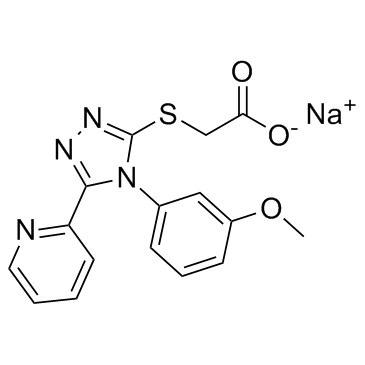1459687-96-7
| Name | GJ-103 sodium salt |
|---|---|
| Synonyms |
GJ103 sodium salt
GJ103 (sodium salt) |
| Description | GJ103 sodium salt is an active analog of the read-through compound GJ072. |
|---|---|
| Related Catalog | |
| In Vitro | Chemical-induced read through of premature stop codons might be exploited as a potential treatment strategy for genetic disorders caused by nonsense mutations. GJ072 is a novel read-through compound (RTC). GJ072 shows activity comparable to stop codons (TGA, TAG, and TAA) PTC124 and RTC13. GJ072 induces ATM kinase on both TGA and TAG stop codons and restored ATMpSer1981 autophosphorylation and SMC1pSer966 transphosphorylation as measured by FACS. GJ072 is active in A-T cells with a homozygous TAA mutation. GJ072 is able to induce detectable full-length ATM protein in treated A-T cells. Early structure-activity relationship studies generates eight active analogs of GJ072. Some GJ072 analogs (e.g., GJ103, GJ106, GJ109, and GJ111) consistently demonstrates their activities in all three PTCs by both FCATMpSer1981 and IRIF assays. GJ071 and GJ072 and some of their analogs (such as GJ103) have similar read-through activity as RTC13 or RTC14, but are more tolerable than RTC13 and RTC14 to A-T cells. GJ103 does not show obvious cytotoxicity in A-T cells at concentration as high as 300 μM[1]. |
| In Vivo | GJ103 sodium salt is water soluble, making it much easier to work with in in vivo experiments[1]. |
| Cell Assay | Cytotoxicity is measured by cell proliferation assay. Cells are seeded into a flat-bottom 96-well plate, including control wells containing complete growth medium alone as blank absorbance readings. After RTC treatment (GJ103), activated-XTT Solution is added into each well, and the cells are returned to the cell culture incubator for 12-14 hours. The absorbance is measured at 480 nM with relevant 630 nM to assess nonspecific readings[1]. |
| References |
| Molecular Formula | C16H13N4NaO3S |
|---|---|
| Molecular Weight | 364.35 |
| Appearance | yellow |
| Storage condition | 2-8℃ |
